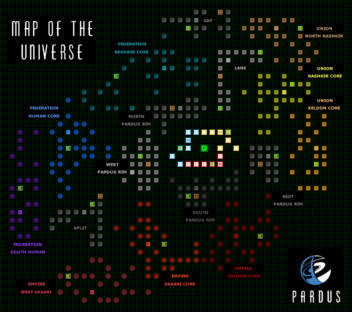Mobility in an online world: Difference between revisions
From Santa Fe Institute Events Wiki
No edit summary |
No edit summary |
||
| Line 37: | Line 37: | ||
==Meetings== | ==Meetings== | ||
* June 10, 5 | * Thursday, June 10, 5 PM, lecture room | ||
* Sunday, June 13, 8:30 PM, cafeteria (next to bookshop) | |||
Revision as of 22:11, 13 June 2010
| CSSS Santa Fe 2010 |
Team
Michael Szell, Giovanni Petri, Kang Zhao, Drew Levin
Intro

The topology of this online world can be expressed as a network, where sectors are nodes (placed on a cartesian grid) and wormholes are links between nearby sectors. A second type of link, the X-hole, links distant sectors, thus giving the universe a small-world property. Players live and move in this environment. For a fixed time for each day and each of the 10^4-10^5 players, we know their locations. (All data is fully anonymized!)
Tasks
- Extract data of universe
- Bring topology data in network format (adjacency list / sparse matrix)
- Visualize network, e.g. in PAJEK, G-PHI
- Extract mobility data of players
- Bring them in reasonable format (time-series). E.g. Time-series of daily hops.
- Analyze data
- Visualize time-evolving data (over the whole time-span: 1. display locations of 5 typical player, 2. display locations of 100 players in war)
- Formulate research questions
- Find literature on mobility, etc.
- Write paper (tex)
Data -> Calculations/Measures
- Time-series of distances travelled (over a time-span) -> Spatial entropy, COV matrix
- Number of unique places visited (over a time-span)
- Time-series of changed friends/enemies -> Social entropy
Research Questions
- How is spatial/social entropy distributed? Do we see modes? If so, why?
- Does mobility change in times of war?
- Do locations and friends/enemies correlate? If so, is there causality?
- ...
Meetings
- Thursday, June 10, 5 PM, lecture room
- Sunday, June 13, 8:30 PM, cafeteria (next to bookshop)
